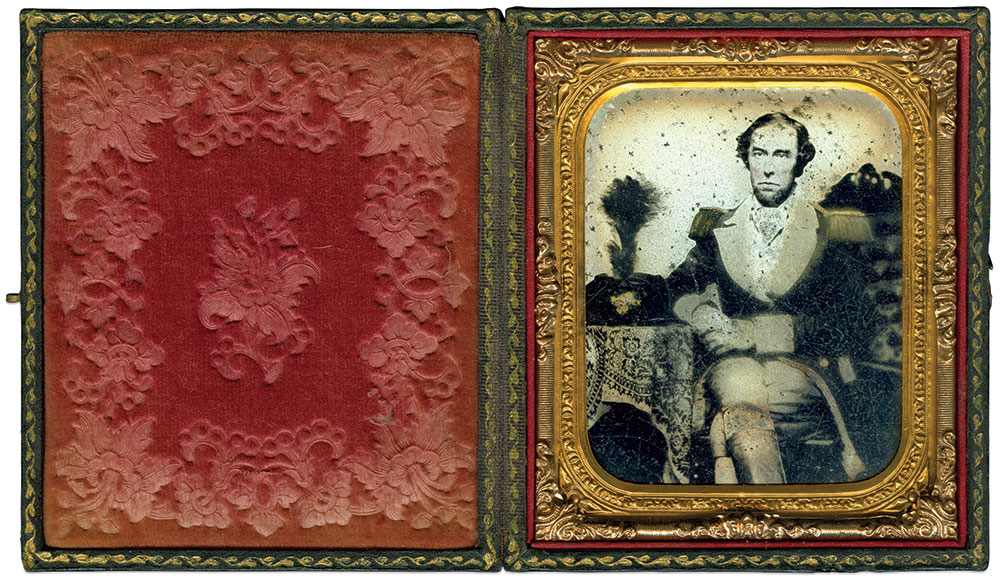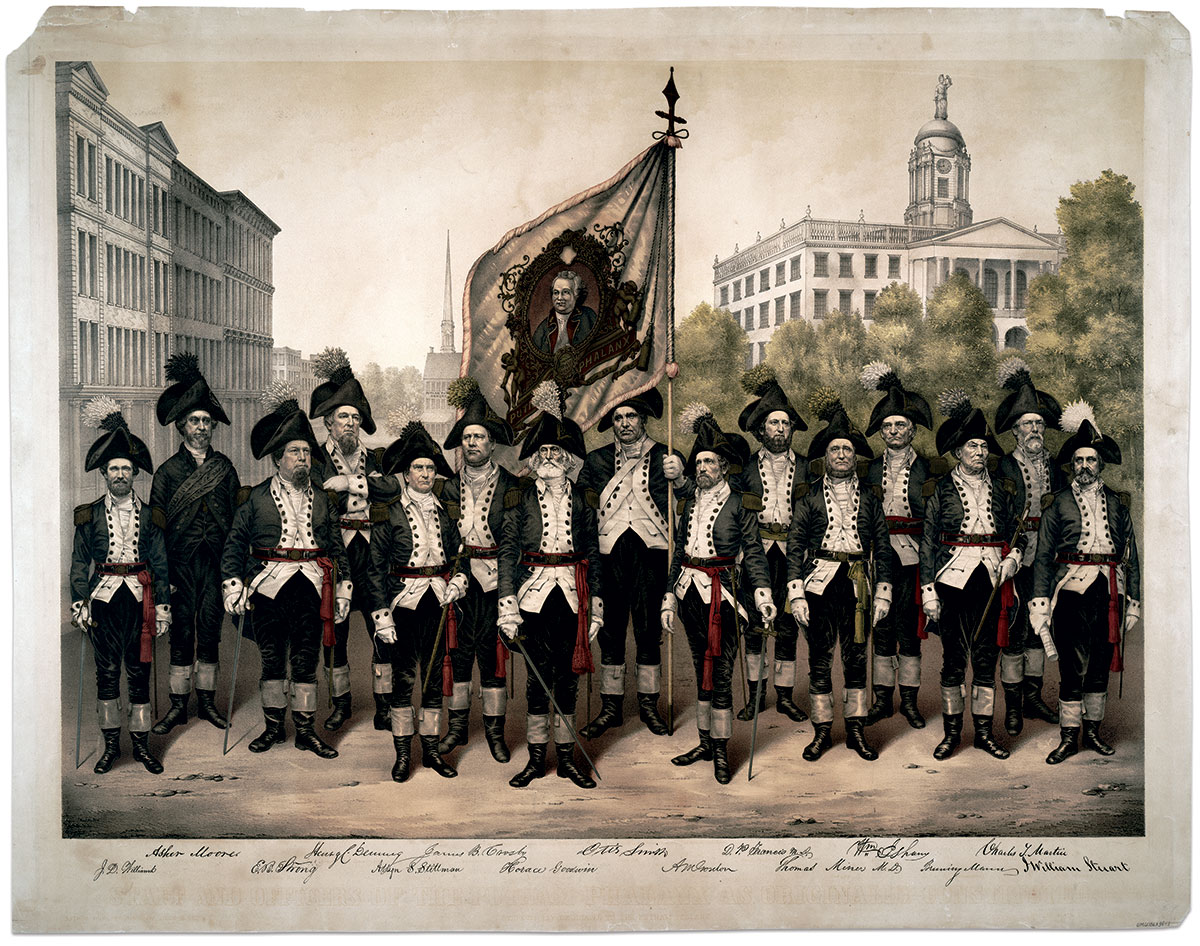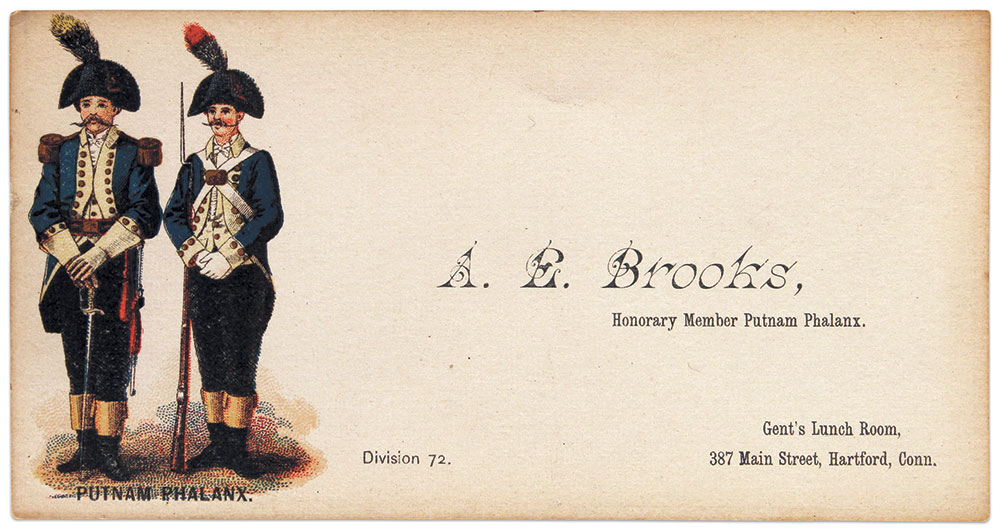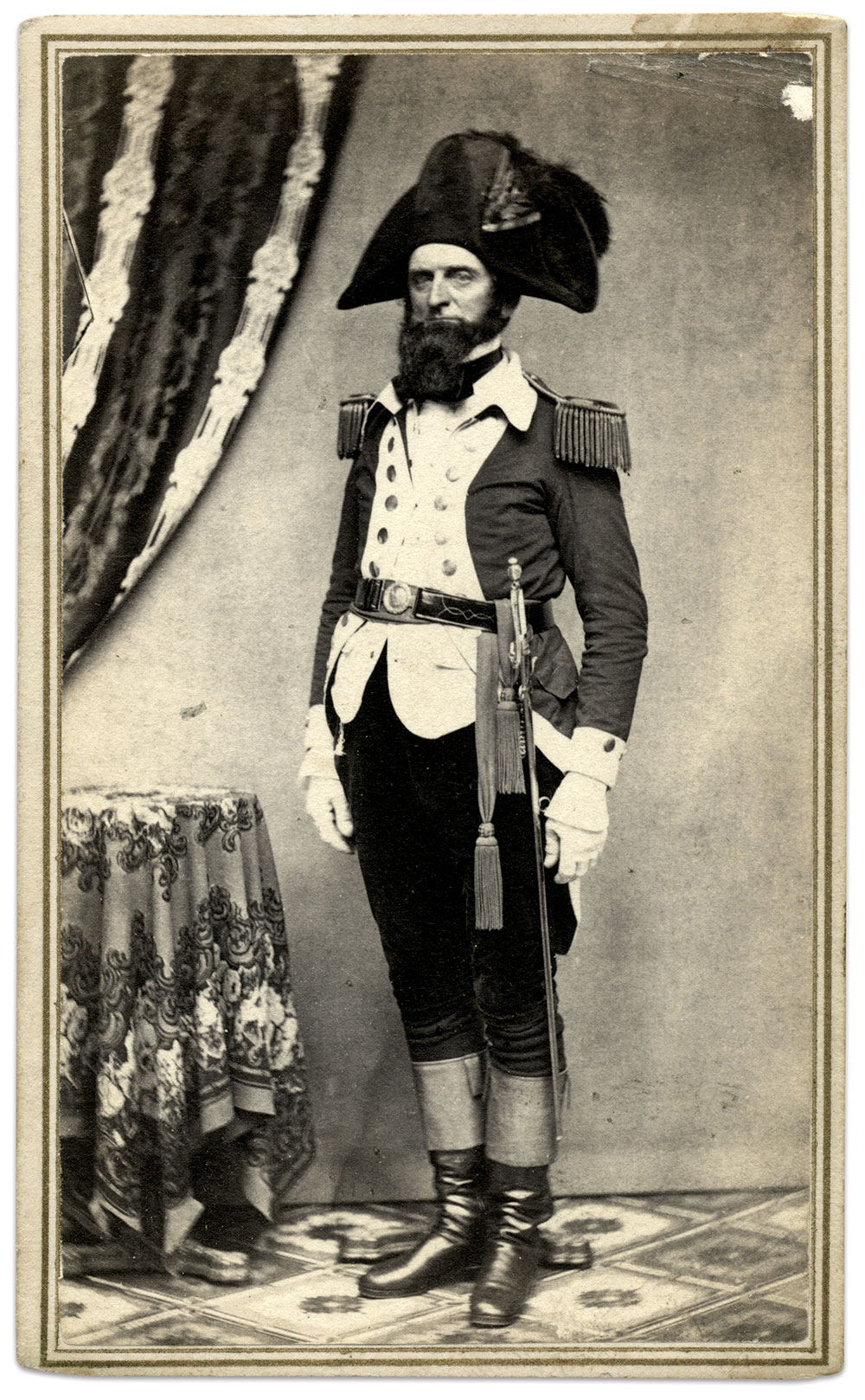
By Ron Field
During the decade before the Civil War, numerous volunteer militia companies drilled and paraded in uniforms based on those worn by the Continental Army, and patterned after “The Old Seventy-Sixers” of the War of Independence. The most likely reason for the popularity of the Continental-style uniform with its cocked hat, blue tail-coat and buff breeches was a desire among part-time American soldiery to adopt a mantle of patriotism, and to re-awaken the glorious memories of the Revolution. Militia companies wearing Continental-style uniforms regularly paraded throughout the North and South to observe the anniversary of George Washington’s birthday, to attend anniversary celebrations of Revolutionary War battles, or to pay funeral respects to those who fought in those battles and those of the War of 1812.
Documenting the styles
Several books produced during the 1850s reflected a desire to celebrate the revolutionary heritage of the nation, and may have influenced the fashion. Benson J. Lossing’s Pictorial Field-Book of the Revolution, published in New York in 1852, contained numerous descriptions and engravings of Revolutionary War flags and militaria. In order that readers should be familiar with “the styles of uniforms worn by the soldiers of the Revolution,” the Charleston Mercury, of South Carolina, published an extract entitled “Military Uniforms” from McHenry’s History of Maryland during April 1860, which described as follows the uniforms of “the several corps of the Continental Army”:
THE GENERAL STAFF – Blue and buff (the ancient Whig colors of England) were adopted by Washington as the uniform of the company that he first commanded at the dawn of our troubles with the mother country. Buff lining to coat; buff under-clothes; black stock; black boots; cocked hat with black ribbon cockade; white plumes for the general officers; yellow buttons and sword mountings. Washington always wore a white stock, and never a plume.
ARTILLERY – Blue coat, red facings and linings; red waistcoat; white breeches; half-leg gaiters; black stock; cocked hat, with black cockade; plume, red and blue, red uppermost; and yellow buttons.
INFANTRY – Blue coat with red facings; white lining and white under-clothes; black gaiters and stock; cap with blue and white plumes. Light Infantry—Short coatee, with blue and white plumes, with buttons, and silver sword-mountings.
LIFE GUARD – Blue coat with white facings; white underclothes; white lining; black gaiters; blue and white plumes. Officers—Cocked hats, blue and white plumes.
Part of the Nativism political movement
Another factor encouraging the wearing of Continental-style uniforms was the feeling of Nativism, a response by many white Americans to the waves of European immigrants flooding into the country between 1846 and 1854. For example, on May 17, 1852, The Sun, a Philadelphia newspaper, reported that “a number of young gentlemen of Newark, N.J., … resolved to organize a military company on Native American principles, to be called the American Continentals.”

By 1853 a number of Nativist societies had combined to create the “Order of the Star-Spangled Banner” which, in turn, politically became known as the American Party or the “Know-Nothings” because, when questioned by outsiders, members were required to pretend to “know nothing.” Led by former President Millard Fillmore, the Know Nothings devoted themselves to limiting the political power of immigrants, thereby “purifying” American politics. With the outbreak of the Civil War in 1861, Fillmore helped organize the Union Continentals in Buffalo, N.Y. Composed of prominent and wealthy citizens too old for active service, this company was commanded by Fillmore, who held the rank of major and served as a Home Guard throughout the conflict.
Post-Civil War
The Continental-style uniform continued its popularity among National Guard organizations, and became very fashionable during the 1876 Centennial.
Examples

New York Continentals
Two enlisted men of a New York Continental company sport leather fan cockades in their tri-corn hats. Their doeskin trousers, turn-backs on their coats and epaulettes, are tinted yellow. The man at left has an eagle-on-globe state seal disc attached to the top of his cockade, and gold paint obscures the numerals “76.” A “pick and brush” hanging from a coat buttonhole indicates his unit may have carried unconverted flintlocks. Their black leather cross belts probably supported a cartridge box and Model 1842 bayonet scabbard. The bottom edges of their white-topped half-leg gaiters are visible at ankle level.


Continental Guard of New Orleans
Henry Fermor Warner, 18, wears the uniform of the Continental Guard of New Orleans, which included a red and white feather plume in their black tricorn hats. When the company paraded to celebrate George Washington’s birthday on Feb. 22, 1855, the Daily Picayune commented that, “each member looked as if he might have just walked out of [John] Trumbull’s famous picture of the surrender of Cornwallis.” Posing without white cross belts, Warner did not serve with the Continental Guard in the Civil War, but may have enlisted in the Crescent Cadets, Company I, Sumter Regiment. An “H.F. Warner” was enrolled in that unit on Sept. 26, 1861.

Tall Plume
This sober-faced militia private has placed his cocked hat on the photographer’s table. The numerals “76” attached to its cockade have been largely obscured by gold paint. The photographer’s colorist has also applied yellow paint to his epaulettes and red to the tall plume on his hat.

Former Commander-in-ChiefIn 1861, the Union Continentals formed in Buffalo, N.Y., under the command of former President and Nativist leader Millard Fillmore. The company served as a home guard and escort for troops as they departed or returned from the front throughout the war. An effort was made to recruit all members from the ranks of veteran officers of previous wars. As a result, it had the greatest concentration of military experience per soldier of any unit in the North. Another distinction was the fiscal strength of its members. They had a combined net worth reported to be in excess of $20 million (about $600 million today). Fillmore wears the uniform of a captain, complete with plumed tri-corn hat, dress epaulets, double-breasted frock coat, and M1850 Foot Officer’s sword.

In Fillmore’s Company
This unidentified private of the Union Continentals wears a tri-corn hat with painted cockade, civilian coat combined with white dress gloves, and military trousers with double seam stripes painted yellow or gold. Accouterments consist of a waist belt fastened by a frame buckle and supporting a cap pouch and scabbard for an Enfield socket bayonet. His long arm is a rifle made by Buffalo gunsmith Patrick Smith, which measured 52 inches in length, with steel fittings and walnut half stock.

New Orleans Enlisted Man
An unidentified enlisted man of the New Orleans Continental Guard wears white cross belts over his buff-faced blue coat and buff vest. In 1856, this company adopted a fatigue dress consisting of a white linen coat with silver buttons and black pants, which they wore with their tri-corn hats.

Third Company, Washington Continental Guards
Identified by a period ink inscription on the reverse as Lt. John H. Clark of the Third Company, Washington Continental Guards, of New York City, this officer has a fan cockade attached to his tri-corn hat, and a white ruffle shirt with frilled cuffs. His belt plate appears to have the letters CG within a wreath. The blade of his unsheathed Model 1850 Foot Officer’s sword is heavily etched. The bottom edges of his white-topped “boots” indicates they were long detachable gaiters rather than integral parts of the footwear.

Philadelphia’s Continental GuardsWhen organized at the beginning of 1851, the Continental Guards of Philadelphia adopted a Revolutionary War-style uniform. By 1861 it formed part of the Pennsylvania Militia’s Artillery Battalion (3rd Brigade, 1st Division). After the war began, it expanded and formed companies A and E of the 23rd Pennsylvania Infantry. This unidentified sergeant wears his undress uniform, and holds a chasseur-pattern cap. A militia-pattern non-commissioned officer’s sword with Roman helmet pommel and pearl grip is suspended from his waist belt, fastened by an oval “PHG” plate indicating Philadelphia Home Guard. His Continental-style dress coat complete with brass shoulder scales, and a cartridge box and other accoutrements are draped over a column, against which rests an altered Model 1809 Potsdam musket.

Member of the Putnam Phalanx
Distinguished by black breeches and stockings with large cocked hat with black plume, this enlisted man belonged to the Putnam Phalanx. Named for Maj. Gen. Israel Putnam, the hero of Bunker Hill, and made up of the most wealthy and influential citizens of Hartford, Conn., the Putnam Phalanx organized in August 1858 as a two-company battalion. The first continental-style garb worn by this unit were borrowed from the Battalion of Amoskeag Veterans, of Manchester, N.H. By March 1859, It had acquired its own uniforms, claiming its basis on the exact uniform worn by Gen. George Washington when he resigned command of the Continental Army. According to contemporary newspaper accounts, the Putnam Phalanx “procured exact drawings to be made of the identical uniform itself, at the Patent Office in Washington,” which were to be “followed exactly, even to the number, size and color of the buttons, style of pockets, chapeau, boots and all.” Colt’s Patent Fire Arms Manufactory Company likely supplied the rifle musket he holds. The company’s owner, Sam Colt, is believed to have drilled with the Putnam Phalanx. Still in existence by 1931, this unit merged into the Connecticut National Guard, becoming the Putnam Phalanx Veterans Corps in 2007.



An Amoskeag Veteran
Formed in Manchester, N.H., in 1855 by local Judge Col. C.E. Potter, the Battalion of Amoskeag Veterans consisted of men aged 38 to 85, organized into field and staff, with four small companies and a color guard. When they visited Washington, D.C., that year, the Evening Star described them as wearing “black beaver cocked chapeaus, with straight black plume; blue broad-cloth coat, of the ’76 cut, faced with white cashmere; buff cashmere waistcoat; black velvet small clothes [pants], and yellow-topped high boots.” Gilt and black epaulets, crimson sash under waist belt, and Revolutionary War-style sword with short blade distinguish the officer in this image who is identified on the reverse as Asst. Surgeon James H. Crombie. An 1838 graduate of Dartmouth Medical College, he left the Veterans at some point after the war began to become a contract surgeon. He survived his war experience, and lived until 1884.
Ron Field is a Senior Editor of MI.
SPREAD THE WORD: We encourage you to share this story on social media and elsewhere to educate and raise awareness. If you wish to use any image on this page for another purpose, please request permission.
LEARN MORE about Military Images, America’s only magazine dedicated to showcasing, interpreting and preserving Civil War portrait photography.
VISIT OUR STORE to subscribe, renew a subscription, and more.

